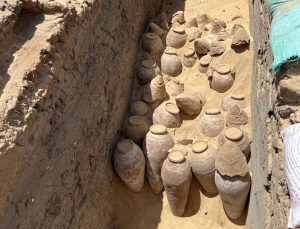Wine, with its enchanting aroma and exquisite taste, has been an integral part of human civilization for thousands of years. Its history is as diverse and rich as the cultures that cultivated it.
Vines can be traced as far back as Pangea 200 million years ago before the split of the continent. In 6500BCE vines in modern day Turkey, Armenia and Georgia were the only ones that survived the last ice age. From here the Canaanites and Phoenicians moved grape through the Mediterranean to Egypt and the rest of ancient world.
In ancient Egypt, wine held a sacred significance, revered as the “Nectar of the Gods” and enjoyed by pharaohs and commoners alike. The Egyptians were skilled viticulturists, cultivating vineyards along the fertile banks of the Nile River. Wine was used in religious ceremonies and as a form of currency.
The recent archeological discovery of hundreds of 5,000- year old wines jar in Queen Meret-Neith’s tomb highlights the cultural significance of wine production in ancient Egypt.
The Greeks elevated wine to a divine status, attributing its creation to Dionysus, the god of wine and fertility. Wine played a central role in Greek culture, from symposia (intellectual gatherings where wine flowed freely) to religious rituals honoring Dionysus. Greek philosophers such as Plato and Aristotle extolled the virtues of wine, viewing it as a symbol of moderation, pleasure, and social harmony. The Greeks further refined winemaking techniques, experimenting with grape varieties, fermentation methods, and aging processes, laying the groundwork for the wines of modern times.
With the rise of the Roman Empire, wine assumed a position of unparalleled importance, symbolizing wealth, power, and sophistication. The Romans expanded vine cultivation across their vast territories, from the hills of Italy to the vineyards of modern-day France and Spain. Wine became a staple of Roman daily life, consumed at lavish banquets, public festivals, and military triumphs. Roman soldiers are said to have drunk wine in their march to war as it was safer than water.
The Romans introduced innovations such as wooden barrels for aging and transporting wine, as well as advanced farming techniques, revolutionizing winemaking on an industrial scale.
With the fall of the Roman Empire, wine production thrived in the monasteries of Europe, where monks meticulously tended to vineyards and perfected the art of winemaking. Monastic orders such as the Benedictines and Cistercians played a pivotal role in preserving and advancing viticulture knowledge, with abbey vineyards becoming renowned for their quality wines. The concept of terroir (the unique combination of soil, climate, and topography) emerged during this period, shaping the character and identity of wines from distinct regions.
The Age of Exploration in the 15th and 16th centuries brought European grapevines to the New World, where they flourished in the fertile soils of regions such as South America, North America, South Africa, New Zealand and Australia. European settlers established vineyards in colonial territories, introducing Old World winemaking traditions to the New World. Over time, these regions developed their own unique winemaking styles and grape varietals, influenced by local climates, soils, and cultural heritage. Today, the New World is celebrated for its diverse array of wines, from bold and fruity Argentinian Malbecs to crisp and aromatic New Zealand Sauvignon Blancs.
As we reflect on the history of wine, we are reminded of its enduring legacy as a symbol of civilization, culture, and conviviality.
Wine has transcended borders and generations, uniting people in a shared appreciation for the simple pleasures of life. As we raise our glasses in celebration, let us toast to the timeless spirit of exploration, discovery, and camaraderie that defines the world of wine.



